 |
Success to the British Fisheries, 1750-51, probably Birmingham. 12.4 cm wide, 9.8 cm high held by the V&A. |
This is the earliest known example of the transfer-printing process on enamel. The transfer-print is in red, on white enamel with a copper base, and framed in a gilt metal frame.
As an early example, the process hasn’t been mastered yet, and the lines were a little powdery and needed to be over-painted in places. The plaque is held by the V&A, who state that it 'commemorates the foundation by Royal Charter of the "Free British Fishery Society" or British Herring Fishery Company, on 25 October 1750'. The design is similar to other Birmingham enamels of this period, including the picturing of swans, which was a re-used motif on Birmingham enamels.
Engravers known to be working on producing prints to transfer onto enamel at this time were John Brooks and Robert Hancock.*
Development of Transfer Printing
 |
| Enamel plaque of the King of Prussia by J. Sadler of Liverpool, c. 1758. Sold at Bonham's in 2009 for £1,920. |
Transfer printing was the process of applying copperplate prints to the surface of enamel. It was possibly developed in Liverpool in about 1749, as was claimed by two engravers of the town, John Sadler and Guy Green.*14* Whether this was true or not, John Sadler produced a variety of transfer printed enamels till about the 1770s (image above), as well as prints on earthenware.
The earliest known surviving transfer printed enamel (above) is generally thought to have been made in Birmingham. In 1751 a Birmingham-based engraver, John Brooks, attempted to take out a patent for the process but a year later apologised in the local newspaper, Aris's Birmingham Gazette, that 'he never intended to encourage a Monopoly in that Branch of the Trade', suggesting that it was not his invention and was already being practiced in Birmingham.*15* Brooks later moved to London and formed a partnership with Stephen Theodore Jansen and Henry Delamain in setting up the Battersea enamel manufactory producing printed enamels.*16*
 |
| Base of snuff-box with transfer print of owl and birds, c. 1758-60. Probably Birmingham made, see more on this print here. |
The trade continued in Birmingham under several makers, and one of the largest enamel makers was John Taylor, possibly employing up to 200 people across the enamelling and gilding trades. As well a painting enamel boxes, Taylor's manufactory produced transfer-printed enamel. Lady Shelburne visited the enamelling part of Taylor's factory in 1766 and described the transfer printing of enamel:
At Mr. Taylor's we met again, and he made and enamel'd a landscape on the top of a box before us, which he afterwards gave me as a curiosity from my having seen it done. The method of doing it is this: a stamping instrument managed only by one woman first impresses the picture on paper, which paper is then laid even upon a piece of white enamel and rubbed hard with a knife or instrument like it, till it is marked upon the box. Then there is spread over it with a brush some metallic colour reduced to a fine powder which adheres to the moist part, and, by putting it afterwards into an oven for a few minutes, the whole is completed by fixing the colour.*17*
The Battersea factory in London was open between 1753 and 1756. Although transfer printing had been conducted in Birmingham for at least two years already, many of the early Birmingham transfer prints were overpainted, so Battersea goods were the first time London shoppers saw and bought transfer-printed enamels. Horace Walpole wrote to his friend Richard Bentley in 1755 sending him ‘trifling snuff box’ which he sent to a friend as a ‘sample of the new manufacture at Battersea, which is done with copper-plates' and Walpole had his own ‘cabinet of enamels’ where he displayed intriguing samples of the manufacture.*18* After the closure of the Battersea factory in 1756, they advertised their remaining stock for sale, which included:
A quantity of beautiful enamel, coloured and uncoloured, […] and never yet exhibited to the public view, consisting of snuff boxes of all sizes, of great variety of patterns, […], very proper ornaments for the cabinets of the curious, bottle-tickets, with chains for all sorts of liquors and of different subjects, watch-cases, tooth-pick-cases, coat and sleeve buttons and other curiosities.*19*
Notes
* The plaque (top image) is sometimes claimed to have been designed by the London-based engraver Louis Philippe Boitard, but this is not currently evidenced. Victorian and early 1900s scholars thought that only London produced these goods, which has since been disproved. See Susan Benjamin, English Enamel Boxes (1978).

